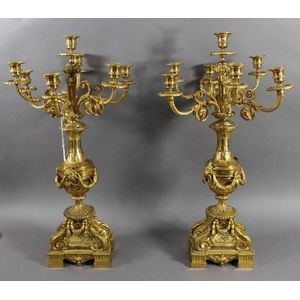Sevres Porcelain Candelabra with Ormolu Decoration
A pair of Sevres pattern ormolu and porcelain candelabra, late 19th Century, (2) the six branch ormolu candelabra inset with Sevres pattern porcelain with ovoid reserves decorated with coloured flowers and cherubs respectively, on a celeste blue ground, highlighted with gilding, each supported on four tapering feet, (2), 50.5 cm high, 30 cm wide, 27.5 cm deep
You must be a subscriber, and be logged in to view price and dealer details.
Subscribe Now to view actual auction price for this item
When you subscribe, you have the option of setting the currency in which to display prices to $Au, $US, $NZ or Stg.
This item has been sold, and the description, image and price are for reference purposes only.
- Oviform /ovoid - The outline loosely resembling the shape of an egg.
- Gilding - Gilding is a method of ornamentation whereby a thin sheet of gold metal is applied to items made of wood, leather, ceramics, glass and silver for decorative purposes.
For furniture including mirrors, the sheet of gold is usually applied over a coating of gesso. Gesso is a mixture of plaster of Paris and gypsum mixed with water and then applied to the carved wooden frames of mirrors and picture frames as a base for applying the gold leaf. After numerous coats of gesso have been applied, allowed to dry and then sanded a coat of "bole", a usually red coloured mixture of clay and glue is brushed on and allowed to dry, after which the gold leaf is applied. Over time parts of the gilding will rub off so the base colour can be seen. In water gilding, this was generally a blue colour, while in oil gilding, the under layer was often yellow. In Victorian times, gilders frequently used red as a pigment beneath the gold leaf.
Metal was often gilded by a process known as fire gilding. Gold mixed with mercury was applied and heated, causing the mercury to evaporate, the long-term effect of which was to kill or disable the craftsman or woman from mercury poisoning. The pursuit of beauty has claimed many victims, not the least of which were the artists who made those pieces so highly sought after today. - Ormolu - Ormolu was popular with French craftsmen in the 18th and 19th century for ornamental fittings for furniture, clocks and other decorative items. True ormolu is gilt bronze, that is bronze that has been coated with gold using a mercury amalgam. Due to the health risks associated with using mercury, this method of creating ormolu was discontinued in France in the 1830s. A substitute was developed consisting of about 75% copper and 25% zinc, however it was inferior to the bronze version. It was often lacquered to prevent it tarnishing.
This item has been included into following indexes:
Visually similar items

Pair of gilt metal and porcelain two stick candlesticks, approx 25 cm high
Sold by
in
for
You can display prices in $Au, $US, $NZ or Stg.

Impressive pair of antique French gilt bronze seven light candelabra, each, 67 cm high, (2)
Sold by
in
for
You can display prices in $Au, $US, $NZ or Stg.

Pair of antique 19th century gilt bronze four stick candelabra, baluster turned support, standing on tri form bases, 49 cm high (2)
Sold by
in
for
You can display prices in $Au, $US, $NZ or Stg.

Pair of antique gilt bronze candelabras, 46 cm high (2)
Sold by
in
for
You can display prices in $Au, $US, $NZ or Stg.
